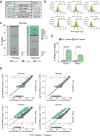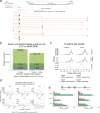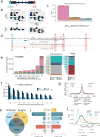High-throughput annotation of full-length long noncoding RNAs with capture long-read sequencing
- PMID: 29106417
- PMCID: PMC5709232
- DOI: 10.1038/ng.3988
High-throughput annotation of full-length long noncoding RNAs with capture long-read sequencing
Abstract
Accurate annotation of genes and their transcripts is a foundation of genomics, but currently no annotation technique combines throughput and accuracy. As a result, reference gene collections remain incomplete-many gene models are fragmentary, and thousands more remain uncataloged, particularly for long noncoding RNAs (lncRNAs). To accelerate lncRNA annotation, the GENCODE consortium has developed RNA Capture Long Seq (CLS), which combines targeted RNA capture with third-generation long-read sequencing. Here we present an experimental reannotation of the GENCODE intergenic lncRNA populations in matched human and mouse tissues that resulted in novel transcript models for 3,574 and 561 gene loci, respectively. CLS approximately doubled the annotated complexity of targeted loci, outperforming existing short-read techniques. Full-length transcript models produced by CLS enabled us to definitively characterize the genomic features of lncRNAs, including promoter and gene structure, and protein-coding potential. Thus, CLS removes a long-standing bottleneck in transcriptome annotation and generates manual-quality full-length transcript models at high-throughput scales.
Figures






References
-
- Carninci P, et al. The transcriptional landscape of the mammalian genome. Science. 2005;309:1559–63. - PubMed
MeSH terms
Substances
Grants and funding
LinkOut - more resources
Full Text Sources
Other Literature Sources
Molecular Biology Databases
Research Materials

